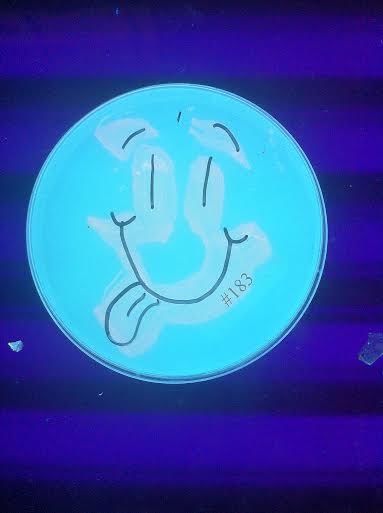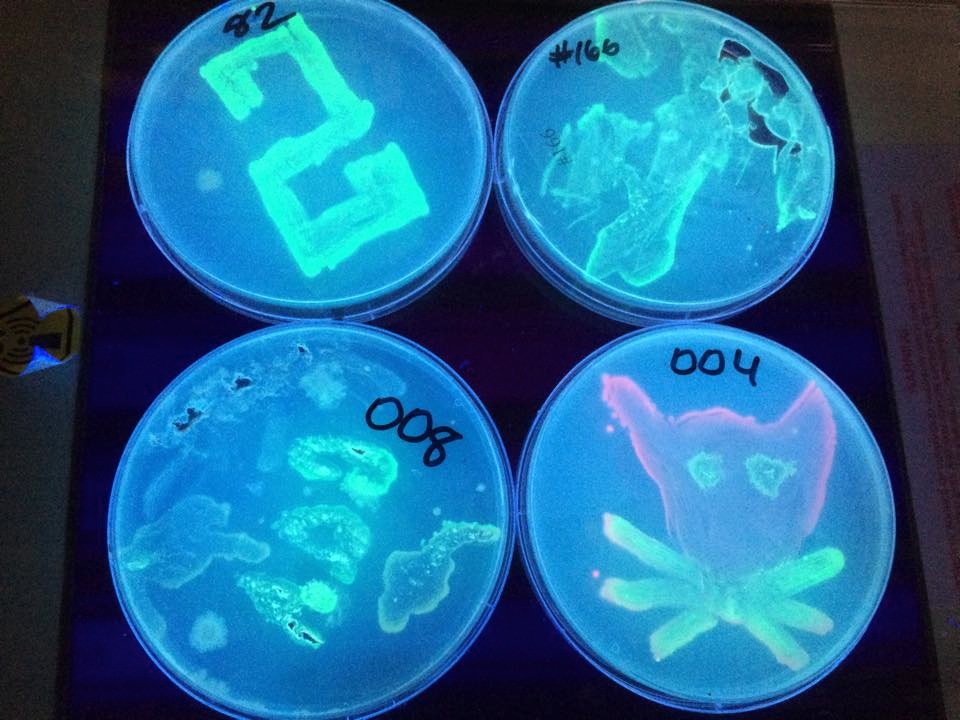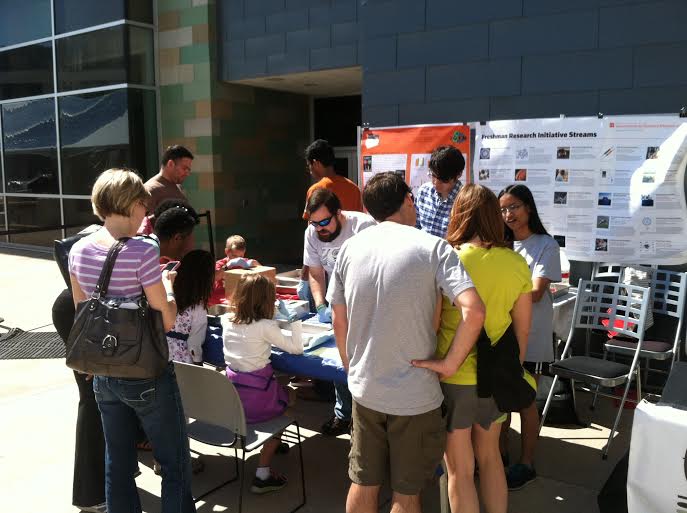Difference between revisions of "Team:Austin UTexas/Practices"
Kvasudevan (Talk | contribs) |
|||
| Line 2: | Line 2: | ||
= Human Practices = | = Human Practices = | ||
| + | The process of genetically enhancing organisms to perform a designated task can have myriad applications in a variety of different fields (Ferry, 2012). For instance, advances in synthetic biology can lead to technologies such as bacterial photography, tumor-targeting bacteria, and biofuels (Sleight, 2010). However, in order for a genetically enhanced organism to perform its desired function reliably, the installed genes must persist through numerous generations. Since all engineered organisms will continue to evolve as they reproduce, designing an organism to maintain a function nonessential for survival for a sustained period of time can be challenging. By learning more about genetic stability, we can develop ways to increase it in the devices we design in the future. This will facilitate the development of novel technologies, which can eventually benefit any aspect of life that synthetic biology influences, such as medicine, quality of patient care, and society as a whole | ||
| − | + | Our project was designed to test and improve the genetic stability of genetically engineered fluorescence proteins as a model for other systems such as therapeutic proteins and metabolic pathways. We believe that our work will impact the medical industry by creating DNA sequences that have the ability to maintain gene expression in probiotic bacteria without experiencing significant rates of failure mutations that make these organisms perform less predictably or into a malicious construct. Bacteria are often used in treatments as gut repopulation, the recolonizing of unpopulated intestines with the bacteria necessary for digestive health (Ruder 2011). By ensuring that genetically modified bacteria are as stable as possible, the risks of synthetic biology therapies can be minimized and society’s ability to treat and cure ailments can be increased. | |
| − | + | For instance, the continued depletion of nonrenewable energy sources has created a demand for novel energy sources. While synthetic biology offers one possible solution, its viability is hindered as a result of genetic instability. Since the evolutionary process continues even after an organism is genetically engineered to produce biofuel precursors, the genetic device is at risk. Producing the necessary molecules requires energy and carbon from the cells, which can diminish a cell’s fitness, breaking the genetic circuit. However, the development of a more stable genetic device could lead to a robust method of biofuel production that lasts over many generations and help alleviate the fuel crisis. | |
| − | + | By creating and using these genetically stable circuits, many companies can save time and money when developing synthetic products. For example, Amyris, a company specializing in synthetic biology products, spent $33,202,000 in 2014 to make their biosynthetic models (Amyris 2014). Companies such as this invest millions on genetic devises to make their products, therefore if these genetic devices are unstable then the company will lose a lot of money. Along with big companies, research labs working in this field would benefit in the same way if their devices lasted longer. Making synthetic biology more cost effective and efficient makes the expansion of using synthetic biology to help society greater. By making it more reliable and cheaper, it may also encourage more biohackers who often use community spaces with far less monetary resources to get involved. | |
| − | + | The advancements in this project can be taken to a global level, where the production of many biosynthetic devices/products can be improved dramatically, efficiently, and cost effectively. Using biological systems to create useful products is not only fast but is also less expensive when compared to conventional manufacturing. When it comes to fixing Third World problems such as access to fuels, food, water, or materials in a cost effective and timely manner, stable genetic devices within engineered microorganisms could be the answer. However, synthetic biology can only be helpful if the devices we make can perform for a long period of time. A village in a country without stable power will not have the ability to simply thaw out another tube of bacteria, should their device-containing bacteria mutate to break the device. By addressing and solving the issue of stability we can deploy synthetic biology for the betterment of society and the future of science. | |
Latest revision as of 03:51, 19 September 2015
Human Practices
The process of genetically enhancing organisms to perform a designated task can have myriad applications in a variety of different fields (Ferry, 2012). For instance, advances in synthetic biology can lead to technologies such as bacterial photography, tumor-targeting bacteria, and biofuels (Sleight, 2010). However, in order for a genetically enhanced organism to perform its desired function reliably, the installed genes must persist through numerous generations. Since all engineered organisms will continue to evolve as they reproduce, designing an organism to maintain a function nonessential for survival for a sustained period of time can be challenging. By learning more about genetic stability, we can develop ways to increase it in the devices we design in the future. This will facilitate the development of novel technologies, which can eventually benefit any aspect of life that synthetic biology influences, such as medicine, quality of patient care, and society as a whole
Our project was designed to test and improve the genetic stability of genetically engineered fluorescence proteins as a model for other systems such as therapeutic proteins and metabolic pathways. We believe that our work will impact the medical industry by creating DNA sequences that have the ability to maintain gene expression in probiotic bacteria without experiencing significant rates of failure mutations that make these organisms perform less predictably or into a malicious construct. Bacteria are often used in treatments as gut repopulation, the recolonizing of unpopulated intestines with the bacteria necessary for digestive health (Ruder 2011). By ensuring that genetically modified bacteria are as stable as possible, the risks of synthetic biology therapies can be minimized and society’s ability to treat and cure ailments can be increased.
For instance, the continued depletion of nonrenewable energy sources has created a demand for novel energy sources. While synthetic biology offers one possible solution, its viability is hindered as a result of genetic instability. Since the evolutionary process continues even after an organism is genetically engineered to produce biofuel precursors, the genetic device is at risk. Producing the necessary molecules requires energy and carbon from the cells, which can diminish a cell’s fitness, breaking the genetic circuit. However, the development of a more stable genetic device could lead to a robust method of biofuel production that lasts over many generations and help alleviate the fuel crisis.
By creating and using these genetically stable circuits, many companies can save time and money when developing synthetic products. For example, Amyris, a company specializing in synthetic biology products, spent $33,202,000 in 2014 to make their biosynthetic models (Amyris 2014). Companies such as this invest millions on genetic devises to make their products, therefore if these genetic devices are unstable then the company will lose a lot of money. Along with big companies, research labs working in this field would benefit in the same way if their devices lasted longer. Making synthetic biology more cost effective and efficient makes the expansion of using synthetic biology to help society greater. By making it more reliable and cheaper, it may also encourage more biohackers who often use community spaces with far less monetary resources to get involved.
The advancements in this project can be taken to a global level, where the production of many biosynthetic devices/products can be improved dramatically, efficiently, and cost effectively. Using biological systems to create useful products is not only fast but is also less expensive when compared to conventional manufacturing. When it comes to fixing Third World problems such as access to fuels, food, water, or materials in a cost effective and timely manner, stable genetic devices within engineered microorganisms could be the answer. However, synthetic biology can only be helpful if the devices we make can perform for a long period of time. A village in a country without stable power will not have the ability to simply thaw out another tube of bacteria, should their device-containing bacteria mutate to break the device. By addressing and solving the issue of stability we can deploy synthetic biology for the betterment of society and the future of science.
South By South West
The 2015 iGEM group had the opportunity to present at Austin's premier festival South By South West Create, that offers a unique convergence of emerging technologies and partners with community support. One of the main concerns for the exponentially growing field of synthetic biology is bridging the gap between science and society. Understanding the sociological components of introducing new synthetic technology to the public is an area that needs more intervention from scientists and the government. At this year's 2015 SXSW Create, we decided to help our local community better understand what synthetic biology is all about, while also promoting STEM education. Over the course of the weekend, we created an interactive synthetic biology booth called "Painting with E. coli", where participants can use various fluorescent E. coli to "paint" on agar plates. Fluorescent bacteria in the colors red, cyan, blue, yellow, and green were prepared in our lab using BioBrick parts.Initially, participants were hesitant in using E. coli, as they connected it with the harmful virulent E. coli usually reported in the news as causing food poisoning and even deaths. Our lab members spent time talking with each participants to gain an understanding of current opinions on synthetic biology and GMO's, while also trying to correct common misunderstandings and highlight the benefits of the uses of this field. From these preliminary verbal surveys and interactions with the local community, we found the most common worries people have about synthetic biology is bioterrorism, creating radically new pathogens, DIY biology that can be used by anyone for harm, and toxins in GMOs that are unsafe. Our goal was to communicate the effectiveness of synthetic biology in allowing researchers to reduce costs of medicines, such as Insulin, increase effiency in manufacturing, creating biocontrolled bacteria to promote plant growth during drought stress to increase agricultural productivity, among other things. At the heart of the Texas Capitol, with the riffs and runnings of the State Government, policy advocates, and unique conference such as SXSW, we hope to partner with others in improving to the public's knowledge of synthetic biology through outreach, education, and awareness. From a personal perspective, we have encountered peers at the University that are not entirely well-versed on the benefits of this technology, but slowly iGEM at the University of Texas at Austin is making a bigger contribution in educating our peers and reaching out to the entire community.
References
- Amyris. 2014 Annual Report, December 31st, 2014. Web. September 10th, 2015.
- Borody, Thomas J., and Alexander Khoruts. "Fecal microbiota transplantation and emerging applications." Nature reviews gastroenterology and hepatology 9.2 (2012): 88-96.
- Ferry, M.S., Hasty, J., Cookson, N.A. (2012) Synthetic biology approaches to biofuel production. Biofuels 3: 9-12.
- Ruder, Warren C., Ting Lu, and James J. Collins. "Synthetic biology moving into the clinic." Science 333.6047 (2011): 1248-1252.


